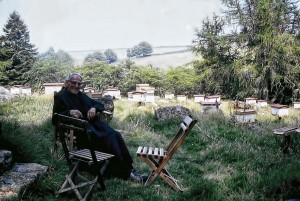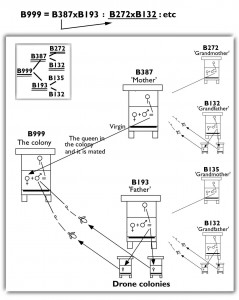This is a too long story to be told in one post here. But I have to start somewhere. I first visited Brother Adam and Buckfast Abbey in 1983. I was allowed to look into his pedigrees for his bees and his world of beekeeping started to unfold. I returned several times. I learned his way of breeding, brought breeding material back to Sweden. In the picture he is sitting in his mating station at Shirburton up on Dartmoor, with his six drone producing colonies and all the mating nucs with virgins or newly mated queens.
Everyone, including me, never thought any different thought than what Brother Adam was doing, was what he thought and we should think, that the way he did it, was the way we should do it. No one asked him what he thought about what would be best for us. What he did evidently was what he thought was the best way for him. Beekeepers started to copy his way of breeding with material they got from him and mating virgins at isolated mating stations with sister queens producing drones. Looking at the mother colony of the drone producer queens as the father in the pedigree. And the mother colony as the mother colony
And those that didn’t copy his way of for example mate the virgins and still call their bees Buckfast were looked upon with suspicion. They weren’t true Buckfasts. And no one asked Brother Adam what he thought about it. But he supplied all those that wanted breeding material, including Weavers in Texas, who didn’t used isolated mating stations the way Adam did. Now Adam is dead so we can’t ask him.
But I ran into a hobby beekeeper who visited Brother Adam in 1981. Hans Samland, now a retired firefighter, was humble enough to ask him what he thought was the best way for him as hobby beekeeper with 15 colonies to do his breeding work. Adam knew of the Swedish Buckfast breeding program with isolated mating stations with material from Buckfast. Adam didn’t even suggest Hans to start with imported bees from him. He didn’t say anything about that. He just answered Hans’ question.
– Every year you decide which half of your bees is the least good one. In those colonies you shift queens. You get the queens to put into those colonies by making a daughter queen from each and everyone of the colonies in the best half of your colonies. Let the new queens mate in your apiary.
It’s simple and it was the best way for Hans, according to Adam. Was Adam right? Probably!

